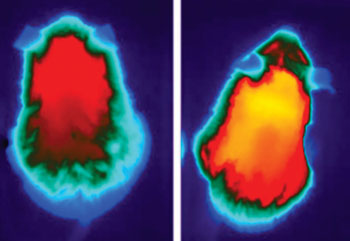High Fat Diet Corrects Mitochondrial Dysfunction in Premature Aging Mouse Model
By LabMedica International staff writers
Posted on 13 Jul 2015
Metabolic disease researchers used a progeroid syndrome mouse model that exhibited symptoms of mitochondrial dysfunction to demonstrate the link between mitochondrial stress and the hormone FGF21 (fibroblast growth factor 21).Posted on 13 Jul 2015
Progeroid means "resembling premature aging", and the progeroid POLG (polymerase gamma mtDNA mutator) mouse model was used by investigators at the Salk Institute (La Jolla, CA, USA) to study mitochondrial disease and premature aging.

Image: In young but rapidly aging mice, high-fat diet feeding (right) ramps up heat production and metabolic activity relative to cooler mice fed a normal chow diet (left) (Photo courtesy of the Salk Institute).
These mice exhibited signs of metabolic imbalance including thermogenic defects in brown adipose tissue (BAT). A side effect of this adaptive response was the complete resistance to diet-induced obesity displayed by POLG mice when they were placed on a high-fat diet (HFD). Surprisingly, HFD further increased oxygen consumption in part by inducing thermogenesis and mitochondrial biogenesis in BAT along with enhanced expression of fibroblast growth factor 21 (FGF21).
FGF21 is a member of the fibroblast growth factor (FGF) family. FGF family members possess broad mitogenic and cell survival activities and are involved in a variety of biological processes including embryonic development, cell growth, morphogenesis, tissue repair, tumor growth, and invasion. Treatment of animals with FGF21 resulted in increased energy expenditure, fat utilization, and lipid excretion.
The investigators reported in the June 29, 2015, online edition of the journal Proceedings of the National Academy of Sciences of the United States of America (PNAS) that the metabolic benefits induced by mild mitochondrial stress via FGF21 induction in POLG mice fed a high-fat diet enabled those mice to resist diet-induced obesity and its underlying associated disease states. In addition, nutrients from a HFD appeared to reverse metabolic imbalance in these mice. HFD also robustly increased fat metabolism and improved mitochondrial function in brown fat, which mediated adaptive thermogenesis.
"These findings help us understand the link between diet, health, and aging, and they give us the potential to dissect these connections in a molecular way that could lead to therapeutics," said senior author Dr. Ronald Evans, director of the gene expression laboratory at the Salk Institute. "What we believe now is that turning on FGF21 is an adaptation to help this animal maintain its metabolic health. If the mice did not have this hormonal "fountain of youth," they might age even more quickly than they already do."
Related Links:
Salk Institute













